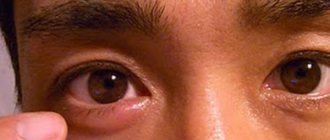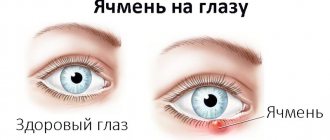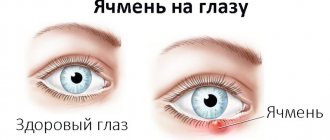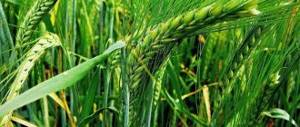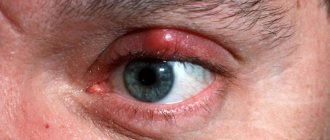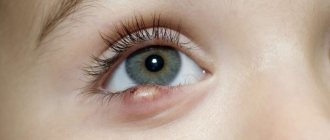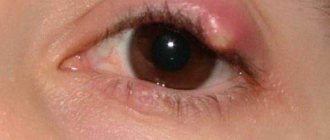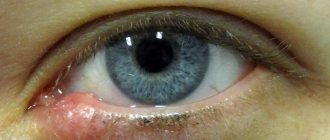Factors for the development of the disease in nursing mothers
The main cause of the disease is a bacterial infection. In 90% of cases, the causative agent is Staphylococcus aureus. Pathology can also be caused by fungal microorganisms and demodex mites, which live on eyelashes. If a microorganism enters the cavity of the hair follicle or sebaceous gland, the excretory duct in the follicle area becomes clogged, the walls of the cavities become inflamed, and pus accumulates in the glands and follicles.
The following risk factors contribute to the appearance of barley:
- scratching eyelids;
- habit of rubbing your eyes with your hands;
- use of dirty napkins, scarves, towels;
- prolonged eye strain;
- use of low-quality or expired cosmetics;
- improper use and storage of contact lenses;
- presence of acne vulgaris;
- oily skin type;
- poor ecology and polluted indoor air;
- HIV infection;
- lack of vitamins A, B and C;
- anemia.
Additional risk factors for breastfeeding mothers include stress, lack of sleep and nervous exhaustion.
The first sign of the disease is itching of the extreme part of the eyelid. After this, the skin begins to turn red, and swelling appears in places where pus accumulates. The formation hurts both with pressure and at rest. Often the swelling is so severe that the patient cannot open her eyes.
The disease develops quickly, so all the signs of barley appear in a short time. The pathology is characterized by a number of symptoms:
- general malaise, headache, fever;
- swelling of the submandibular and parotid lymph nodes;
- itching and severe swelling of the eyelids;
- redness and swelling of the conjunctiva.
2-3 days after the swelling appears, a pustule forms - a purulent head. If a woman decides to pierce the formation on her own, the contents flow out, and the symptoms gradually subside.
Doctors can also diagnose a form of the disease such as internal stye. Forms under the eyelid, inside the cartilage. The conjunctiva turns red and swells. As the barley ripens, pus begins to be visible through the mucous membrane of the eyelid, and after its spontaneous opening, leaf-shaped granulations form.
Causes of stye
In 90% of barley diseases, a pathogen such as Staphylococcus aureus is to blame, but barley can also occur due to a simple blockage of the duct, or due to the fault of streptococcus. Often the disease occurs against the background of colds, weakened immunity, and several purulent foci may occur simultaneously, including in one eye.
Usually, barley goes away on its own in a maximum of 4 days. In this case, the purulent head may not form - if you quickly start treatment at the first symptoms of barley - or the breakthrough and cleansing of the duct occurs on its own. But attempts to independently remove the abscess and open it are sharply condemned by doctors.
What treatment for stye can be used
Treatment of the disease is complicated by the fact that the list of approved medications during this period is narrowing. Drugs with aggressive active ingredients are contraindicated, as they can pass into mother's milk and harm the nursing baby. Before starting treatment, carefully study the composition of the medications and, if possible, consult with your doctor.
Pharmacy drugs
Not all pharmaceutical products are approved for breastfeeding mothers. All medications must be purchased as prescribed by a doctor; below is a list of some of them.
List of medications allowed for hepatitis B
To treat barley, local disinfectants are prescribed: ointments and drops:
- Albucid (sulfacyl sodium) is an antimicrobial and bacteriostatic agent. Penetrates the mucous membrane of the eyes, providing a therapeutic effect half an hour after instillation. It can be taken if the expected benefit for the mother exceeds the possible side effects for the child. During use, pain and lacrimation are possible;
- Tobrex is a broad-spectrum antibacterial agent. It acts locally, practically does not enter the woman’s body, and therefore is not contraindicated during breastfeeding. Possible side effects in the form of headache and discomfort during instillation. With increased sensitivity to the components, allergic reactions develop (up to anaphylactic shock);
- Erythromycin ointment is a bacteriostatic antibiotic that is often prescribed for skin diseases and is not contraindicated in nursing women. Available in ointment form.
When choosing a drug to treat barley, carefully read the instructions for use and study the composition. Any medicine may contain components that are allergens for you and can cause serious consequences for the body.
Acyclovir ointment, hydrocortisone ointment, levomekol, zinc ointment, oxolinic ointment for barley
Hydrocortisone ointment is widely used in the treatment of barley. The ointment is applied in a thin layer 2-3 times a day.
Levomekol ointment, which contains an antibiotic and an immunostimulating agent, also has an antimicrobial effect. Acyclovir ointments, zinc and oxolinic ointments are not intended for the treatment of barley.
Acyclovir ointment is not an antibacterial drug, but is antiviral. This ointment is used in the treatment of diseases caused by herpes viruses.
Oxolinic ointment also has an antiviral effect and is widely used in the prevention of influenza. Zinc ointment is prescribed for eczema, dermatitis and other skin diseases.
IMPORTANT: The ointment may cause short-term blurred vision.
Physiotherapeutic procedures
One of the methods for treating barley is exposure to dry heat. In the absence of contraindications, doctors give young mothers a referral for UHF therapy. This is a method of electrotherapy, which is based on the alternating use of ultra-high frequency electric current.
The procedure provides a number of therapeutic effects:
- relieves pain. Electric current has a beneficial effect on skeletal and smooth muscles, relieving spasms;
- stops inflammatory processes. Currents penetrating the tissues of the eyelids dilate blood vessels, reduce the accumulation and secretion of pus, and normalize cell permeability. Thanks to this, inflammation decreases and does not spread to other areas;
- fights bacteria. The bacteriostatic effect is explained by the fact that electric waves stop the development of pathogens;
- has a trophic effect. Irritates tissue in the affected area. This occurs due to the fact that the flow of oxygen and essential nutrients to the area in which the barley is located increases. As a result, the formation resolves without outside intervention.
What to do if a stye breaks through?
The opening of the stye is a natural reaction of the body, which tries to get rid of the bacterial infection on its own. However, this condition is dangerous because pus can get into the mucous membrane of the eye and cause a new infection. To prevent this from happening, you must follow a number of recommendations:
- apply antimicrobial agents to the eyes daily;
- treat the affected area with antiseptics: alcohol, brilliant green, hydrogen peroxide;
- observe the rules of personal hygiene: wash your hands thoroughly, use only your own towel, if necessary, use antimicrobial wipes or gel;
- Rinse eyes daily with clean water;
- During treatment, avoid using cosmetics and wearing contact lenses.
Doctors also recommend not touching the area where the stye broke out with your hands to avoid re-infection.
What is the danger of disease during lactation?
Many people consider stye a harmless disease and do not pay attention to the inflamed eyelid. If not treated in a timely manner, the disease is dangerous for both the mother and her child.
If the disease is detected at an early stage and treatment is started in a timely manner, then the disease is not dangerous for the young mother. However, if treatment is provided incorrectly, complications may arise in the form of meningitis, sepsis and decreased visual acuity.
For a child
The disease is dangerous because it is caused by infections that can cause damage not only to the eyelid, but also to other parts of the body. Through close contact with the mother, the child can become infected. Another danger is the penetration of the medicine into the baby’s body along with mother’s milk. However, with proper treatment, this can be prevented.
Useful video
Stye on the eye. How to treat?
Treatment of the disease
It is worth treating barley during pregnancy by taking antibacterial, anti-inflammatory, and antiseptic drugs. Many medications have contraindications for breastfeeding, so they must be taken under medical supervision.
Important! It is not recommended to use drug treatment in the early stages of pregnancy - it is dangerous for your unborn baby!
In this case, alternative medicine methods are used to remove barley. They contain natural ingredients that do not cause allergies or addiction.
Treating stye during pregnancy is not difficult if you take action at the first signs of inflammation. In this case, you can get by with folk remedies, which are the most preferable due to the minimum of side effects. If the extent of the disease does not allow it to be treated with such methods, then the doctor may prescribe drug therapy.
Prevention
With proper treatment, the disease goes away in 1-2 weeks. To avoid re-infection, follow proven tips:
- strengthen your immune system. Try, if possible, to follow a daily routine, set aside time for sleep and avoid overwork;
- eat a balanced diet. Eating fast food and other junk food leads to a decrease in immunity, and the body can no longer resist infections;
- Observe the rules of personal hygiene: use only your own towel, regularly remove makeup and cleanse your face after using decorative cosmetics. If you use contact lenses, be sure to rinse them thoroughly and only store them in clean solution.
These simple rules will help you avoid re-infection.
Prevention of stye
To protect yourself from stye in the future, follow these preventive measures:
- maintain personal hygiene;
- do not touch your eyes with dirty hands;
- use your own cosmetics;
- Strengthen your immune system with physical activity, healthy eating, and walks in the fresh air.
By using medications and traditional medicine recipes, you will get rid of stye quickly and safely for your baby.
Feb 21, 2017Anastasia Graudina
Features of stye on the eye during breastfeeding
The ophthalmological disease “stye” is an inflammation of the hair follicle on the mucous membrane of the eye , which appears as a result of exposure to the bacteria Staphylococcus aureus . Rubbing the eyes, getting cosmetics on the mucous membranes, and other failure to comply with personal hygiene rules are the most common reasons for germs entering the human body.
For most people, the disease progresses in a standard sequence. This process is no different for nursing mothers. Redness and swelling of the skin around the eyelid, itching and burning are the first signs of the onset of stye.
After 2-3 days , the purulent core, as a rule, comes out and opens. In this case, body temperature rises in extremely rare cases with accompanying complications of the inflammatory process.
Barley is not a contagious disease ; moreover, the disease does not affect the quality of breast milk or its taste. In this regard, barley in the mother does not pose a danger to the baby’s body. According to doctors, it is possible to cure barley using gentle methods without interrupting breastfeeding.
Symptoms
The inflammatory process can affect the eyelid from the outside or inside. Initial manifestations are characterized by the following symptoms:
- discomfort - itching, burning, tingling;
- redness of the eyelid area;
- swelling;
- pain when touching and blinking;
- sensation of a foreign object in the eye;
- lacrimation.
The abscess matures on the second or third day and a core appears.
On the 2-3rd day of the disease, an abscess with a rod forms, pain decreases. The breakthrough of barley and how healing proceeds depends on the location of the inflammation:
- The process on the inside of the eyelid gradually resolves, and a small scar may remain.
- From the outer eyelid, the pus is completely removed and the affected area is restored.
Additionally, symptoms of general intoxication of the body may appear as an individual reaction of the nursing mother’s body or during the formation of several stye. The condition is accompanied by the following symptoms:
- low-grade body temperature;
- muscle aches;
- headache;
- chills;
- weakness;
- enlarged lymph nodes.
Treatment during lactation
The worries of young mothers that drug treatment of the eye mucosa can harm the baby are largely unfounded . With qualified diagnosis and prescription of medications in the correct dosage, a safe amount of medication for the baby will enter the bloodstream. But out of ignorance, breastfeeding women often prefer to use only gentle folk remedies.
What medications are prescribed for breastfeeding?
Drops containing an antibiotic are the most common form of drugs prescribed by ophthalmologists for the treatment of stye. Nursing mothers are most often prescribed the following gentle medications:
- Levomycetin in drops is a widely used antibiotic; it has a complex effect on the source of inflammation: it disinfects, relieves itching and irritation, and prevents the spread of infection after opening the abscess capsule. The medicine is used according to the standard regimen - 1-2 drops in each eye every 3-5 hours a day, depending on the degree of inflammation of the mucous membrane. When used correctly, the symptoms of the disease disappear within 72-96 hours.
Photo 1. Packaging and bottle of Levomycetin eye drops, dosage 0.5%, volume 10 ml. Manufacturer Dosfarm.
- Tobrex drops and ointment are one of the most gentle medications prescribed even to infants. Prevents the proliferation of staphylococcus, relieves itching and inflammation, soothes the mucous membranes of the eyes. Adults use 2 drops up to 3-5 times a day , the ointment is placed behind the eyelid at night. The course of treatment according to the standard regimen is 5-6 days (the dosage is reduced as the condition improves).
- Albucid drops are good at relieving symptoms of severe inflammation - they are prescribed to nursing mothers in a dosage of 2 drops up to 4-6 times a day (reduce the dosage as inflammation decreases). When applied, a burning and tingling sensation is felt. Incompatible with the use of contact lenses.
Attention! When treating stye, it is strictly forbidden to use medications on your own without consulting an ophthalmologist. Even gentle medications can harm the health of a nursing woman if the diagnosis is incorrect and the dosage of the drug is incorrect!
What is barley?
When getting sick, many mothers try to be treated with weak drugs so that the active substances of the medicine do not pass into breast milk.
Stye on the eye is a fairly common disease caused by the bacterium Staphylococcus. It develops in a weakened body, often when personal hygiene rules are violated.
This disease has certain symptoms: at first, the skin of the eyelids turns red, itches, and a burning sensation appears. Sometimes, if the inflammation is severe, a rise in temperature is observed. Then swelling occurs, and after 3-4 days the stye on the eye ripens.
Barley has no effect on breast milk . It is for this reason that you do not need to stop feeding your baby. Treatment should be gentle, aimed at alleviating the condition.
In cases of hepatitis B, after the consent of the attending physician, it is allowed to use traditional methods of treatment.
Impact of the disease on pregnancy
If barley appears, you should immediately contact a specialist. The course of the disease without complications does not pose a danger to the child. With proper treatment, the infection does not spread beyond the eye area and does not enter the circulatory system. When the development of the disease leads to complications, this poses a threat to the normal development of the fetus.
Important! The inflammatory process can be accompanied by an increase in body temperature and provoke a miscarriage.
During pregnancy, a woman’s vulnerable body also runs the risk of catching this small sore, which brings so much anxiety. It is recommended to avoid medications during pregnancy, especially in the first trimester. In most cases, this is due to little knowledge of the degree of their influence on the fetus.
For example, Albucid drops are not contraindicated during pregnancy and lactation, but the instructions advise using them with caution.
Whenever possible, treat barley with an antiseptic. If the stye occurs in a more serious form, consult a doctor who will select the most gentle treatment based on your situation.
How to treat stye on the eye of a nursing mother during lactation?
A small portion of medications taken by the mother passes into breast milk. In this regard, it is better to stop breastfeeding while taking antibiotics. Both during pregnancy and during breastfeeding, with the permission of a doctor, you can turn to traditional methods of treating barley.
Folk remedies in the treatment of barley
Traditional methods of treatment are safer, but take longer.
- At the initial stage, you need to heat the barley using dry heat. You need to make a bag out of cotton fabric and fill it with sea salt. The bag should be warmed and then applied to the site of inflammation;
- For dry heat, use a hard-boiled egg or potato. There is no need to clean them, this will keep the heat longer. The egg or potato should not be hot, but warm;
- warm the flax seeds in a frying pan or microwave, pour into a bag and warm the reddened eyelid;
- Lubricate the reddened eyelid with a peeled clove of garlic for 2-3 days;
- Lubricate the barley with brilliant green, carefully, without getting it on the mucous membrane. It is enough to repeat the procedure 5 times;
- when the rod has already formed, lotions are made with calendula. To prepare the solution, you need to take 1 tbsp. dry herbs, pour 250 ml of boiling water, let it brew, then strain;
- The method used at the onset of the disease is treatment with 72% laundry soap. They need to soap their hands and apply foam to the swollen eyelid. The foam will cause a strong burning sensation, but you will have to be patient. If you perform this procedure 2-3 times a day, the barley will pass without a ripening phase;
- a mixture of honey and aloe in a 1:1 ratio is applied as a compress 2 times a day;
- Black tea lotions will help relieve inflammation. Tea should be taken without additives and of high quality. Brew it as usual. Soak a cotton pad in a warm solution. Keep on the eyelid for 7-10 minutes up to 4-6 times a day. When there is not much time, it is better to use tea bags;
- Having previously rubbed the burdock root, apply it to the eyelid;
- Apply the yogurt on cheesecloth and keep it on the barley for a few minutes;
- Squeeze juice from fresh aloe. Dilute 1 part juice with 10 parts water. Use the solution for lotions;
- during illness, you need to eat a lot of fruits and vegetables with a high content of vitamin C. Rosehip decoction, a leader in vitamin C content, simultaneously stimulates milk production.
Traditional treatment
Since immunity often decreases during breastfeeding, this formation must be treated, first of all, by directing all efforts to strengthening the defenses.
To do this, it is good to use a complex of vitamins, which is intended for the lactation period. It is necessary to use methods for hardening and natural healing of the body:
- Contrast douches - alternating cold and hot water while taking a shower. At the same time, the blood vessels are effectively trained.
- Gymnastics - daily physical exercise improves blood circulation and strengthens the immune system.
- Daily walks - it is advisable to be outside even in cold weather, at least 15 minutes a day.
Barley should be treated as follows:
- Applying a compress based on chamomile infusion. To prepare it, you need to take dry raw materials in the amount of 2 tbsp. l., which should be poured with a glass of boiling water and put on low heat. It is necessary to cook the product for about 5 minutes and, after cooling, strain the liquid. The decoction is used as a compress, soaking a cotton pad or gauze in it for 15 minutes, 2 times a day.
- Lotions with aloe juice. When breastfeeding, concentrated juice cannot be used, so it should be diluted beforehand. But first of all, you need to choose a larger and juicier leaf. It must be washed thoroughly. Under no circumstances should you use unrefined raw materials. This can only make the situation worse. The squeezed juice should be diluted with water 1:10 and, thoroughly moistening a cotton pad in the solution, apply it to the eye for 20 minutes.
- Rinsing the eyelid with a solution based on calendula. For these purposes, dry raw materials in the amount of 1 tbsp are suitable. l. Pour boiling water over it and let stand for about 1 hour. Then strain the liquid and rinse the eye 2 times a day. One procedure will require 1 glass of infusion.
- Warming up with an egg. One of the most accessible and safest methods is to use a hard-boiled egg. It is capable of retaining heat for a long time. While the egg is hot, you can wrap it in a towel. The affected eye should be warmed 2 times a day for 10 minutes.
During lactation, the list of remedies is limited, since the main thing is not only to get rid of the unpleasant formation, but also to protect the child. Many traditional medicine recipes recommend using laundry soap, as it has a powerful antiseptic effect.
Treatment with medications must be carried out carefully. Self-medication is excluded due to the unsafety of many medications. Therapy is started only after a detailed consultation with an ophthalmologist who observes the patient until she is completely cured.
Local treatment of barley with hepatitis B
Local treatment begins with the use of local antiseptics, which disinfect the affected area and prevent the spread of infection.
The safest is vodka or medical alcohol diluted with water in a 1:1 ratio. Wrap cotton wool around the tip of a match or ear stick, moisten it in antiseptic and gently cauterize the eyelash growth area. You can use a solution of brilliant green.
If a mother develops stye on the eye while breastfeeding, then the choice of drops and ointments requires a professional approach.
The drugs of choice in such cases are:
- Drops for barley: Levomycetin, Zerotex, Tobrex, Floxal, Tsiprolet.
- Ointments and gels: Blepharogel.
If barley appears during breastfeeding, treatment begins immediately. At the initial stage of the disease, while symptoms are just beginning to appear, dry heat is useful. Boil a chicken egg, wrap it in a natural cloth or towel and apply it to the sore spot.
Keep until completely cool. But, if you did not have time to apply heat in the first 2-3 hours after the onset of the disease, then be sure to abandon this method of treatment! Here are a few more recipes.
Recipe No. 1
Brew strong black pure (without any additives) tea. Let it brew, soak a cotton pad in the warm liquid and apply it to the sore eye.
Next, you definitely need to lie down, cover your face with a towel and lie there until the “compress” completely cools down. Tea leaves can be safely replaced with a decoction of chamomile and calendula.
Recipe No. 2
Boil the potatoes with their skins on, peel them and grate them on a fine grater to make a paste-like substance. We place it in a gauze bag and apply it while still warm to the area where the stye is formed.
Recipe No. 3
We use any item made of pure silver. It is necessary to apply it to the sore spot. The antiseptic effect of the metal will help provide first aid at the very beginning of the disease.
Drops for the treatment of stye
Nursing mothers who want to quickly relieve their condition can use antibiotic drops. But many are worried that antibiotics will get into the milk, thereby harming the baby. But the amount of antibiotic that enters the blood is small and cannot harm the child . Ophthalmologists most often prescribe the following drops:
- Albucid - relieves inflammation and swelling of the eyes, but it severely burns the mucous membrane of the eye. In case of severe inflammation, drops are prescribed in a dosage of 2 drops up to 4-6 times a day; when inflammation decreases, reduce to 2-3 times. If redness, itching of the eyelids, and lacrimation are felt, then you need to reduce the number of applications or use a solution with a lower concentration. Albucid should not be used with contact lenses on the eyes or medications with silver salts.
- Levomycetin drops are a topical antibiotic. The medicine has a complex effect on barley, reducing the disease to 3-4 days. The drops perfectly disinfect, prevent possible complications after opening the core of the abscess, and relieve inflammation and itching. Less pungent than albucid. There is a standard scheme for using drops: 1-2 drops in both eyes with a frequency of 4-12 times. The frequency depends on the condition of the stye. If the stye is in one eye, drops are also applied to the healthy eye to prevent infection.
- Tobrex is the most gentle drops that do not cause burning. This drug is used to treat barley in newborns. The dosage is prescribed by the doctor - in small doses the drug blocks the proliferation of bacteria, and in large doses it destroys them. The course of treatment is usually 5-7 days. For more effective treatment, apply Tobrex ointment at night. When the condition improves, the dosage should be reduced. Nursing mothers do not have to worry about the drug passing into breast milk. The medicine leaves the body in the urine.
Antibacterial ointments
For breastfeeding, he recommends using antimicrobial agents in the form of ointments. They are not as convenient to apply to the damaged area as drops. However, the ointment exhibits a therapeutic effect faster due to its thickness. Most often, Erythromycin, Hydrocortisone and Tetracycline ointments are used to treat barley. To facilitate application, use the antimicrobial agent Blefarogel in gel form. The lower eyelid is treated with the product, regardless of the location of the abscess.
Method of using antibacterial ointments:
- Erythromycin ointment eliminates inflammation on the eyelid. The product is applied to the eyelid and left to absorb. The frequency of the procedure is 3 times a day, treatment lasts no longer than 2 weeks.
- Ointment with hydrocortisone eliminates redness, swelling, reduces inflammation, and has an anti-allergenic effect. Apply the product in the same way as in the previous case.
- Tetracycline ointment is used to relieve the inflammatory reaction. Tetracycline is used to treat the eyelid or its lower edge 5 times a day. To do this, with clean hands, pull back the lower eyelid and inject a small amount of the product into the conjunctival cavity.
According to the instructions, all of the above remedies are contraindicated for nursing mothers. However, doctors often prescribe them to women in a safe dosage if the risk to the baby is less than the potential benefit to the mother. During the treatment period, the newborn is transferred to artificial feeding.


